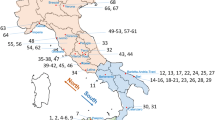Abstract
The relationships between FA and the volatile profiles of olive and walnut oils from Argentina were studied using GC and solid-phase microextraction coupled with GC-MS. The major volatiles were aldehydes and hydrocarbons, produced mainly through the oxidative pathways. n-Pentane, nonanal, and 2,4-decadienal were predominant in walnut oils, whereas nonanal, 2-decenal, and 2-undecenal were the most abundant components in olive oils. A multivariate analysis applied to the chemical data emphasized the differences between the oils and allowed us to see a pattern of covariation among the FA and the volatile compounds. The main differences between walnut and olive oils were the presence of larger amounts of short-chain (C5–C6) saturated hydrocarbons and aldehydes in the former and the greater quantities of medium-chain (C7–C11) compounds in olive oil. This can be explained by their different origins, mainly from the linoleic acid in walnut oil or almost exclusively from the oleic acid in olive oil.
Similar content being viewed by others
References
Morales, M.T., J.J. Ríos, and R. Aparicio, Changes in the Volatile Composition of Virgin Olive Oil During Oxidation: Flavors and Off-flavors, J. Agric. Food Chem. 45:2666–2673 (1996).
Kiritsakis, A.K., Flavor Components of Olive Oil—A Review, J. Am. Oil Chem. Soc. 75:673–681 (1998).
Angerosa F., R. Mostallino, C. Basti, and R. Vito, Virgin Olive Oil Odour Notes: Their Relationships with Volatile Compounds from the Lipoxygenase Pathway and Secoiridoid Compounds, Food Chem. 68:283–287 (2000).
Angerosa, F., C. Basti, and R. Vito, Virgin Olive Oil Volatile Compounds from Lipoxygenase Pathway and Characterization of Some Italian Cultivars, J. Agric. Food Chem. 47:836–839 (1999).
Cavalli, J., X. Fernandez, L. Lizzani-Cuvelier, and A. Loiseau, Characterizacion of Volatile Compounds of French and Spanish Virgin Olive Oils by HS-SPME: Identification of Quality-Freshness Markers, Food Chem. 88:151–157 (2004).
Tura, D., P.D. Prenzler, D.R. Bedgood, Jr., M. Antolovich, and K. Robards, Varietal and Processing Effects on the Volatile Profile of Australian Olive Oils. 84:341–349 (2004).
Clark, R.G., and H.E. Nursten, Volatile Flavour Components of Walnuts (Juglans regia L.), J. Sci. Food Agric. 27:902–908 (1976).
Caja, M.M., M.L. Ruiz del Castillo, R. Martínez Alvarez, M. Herraiz, and G.P. Blanch, Analysis of Volatile Compounds in Edible Oils Using Simultaneous Distillation-Solvent Extraction and Direct Coupling of Liquid Chromatography with Gas Chromatography, Eur. Food Res. Technol. 211:45–51 (2000).
Uceda, M., and M. Hermoso, La Calidad del Aceite de Oliva, in El Cultivo del Olivo, edited by D. Barranco, R. Rernández-Escobar, and L. Rallo, Ediciones Mundi-Prensa, Madrid, 1999, pp. 571–596.
Savage, G.P., P.C. Dutta, and D.L. McNeil, Fatty Acid and Tocopherol Contents and Oxidative Stability of Walnut Oils, J. Am. Oil Chem. Soc. 76:1059–1063 (1999).
Demir, C., and M. Çetin, Determination of Tocopherols, Fatty Acids and Oxidative Stability of Pecan, Walnut and Sunflower Oils, D. Lebens.-Runds. 95:278–282 (1999).
Tobares, L., C. Guzmán, and D.M. Maestri, Effect of the Extraction and Bleaching Processes on Jojoba (Simmondsia chinensis) Wax Quality, Eur. J. Lipid Sci. Technol. 105:749–753 (2003).
Maestri, D.M., and C.A. Guzmán, A Comparative Study of Seed Lipid Components of Nicotianeae (Solanaceae), Biochem. Syst. Ecol. 23:201–207 (1995).
Reiners, J., and W. Grosch, Odorants of Virgin Olive Oils with Different Flavor Profiles, J. Agric. Food Chem. 46:2754–2763 (1998).
Olías, J.M., A.G. Pérez, J.J. Ríos, and L. Sanz, Aroma of Virgin Olive Oil: Biogenesis of the “Green” Odor Notes, 41:2368–2373 (1993).
Frankel, E.N., Chemistry of Autoxidation: Mechanism, Products and Flavor Significance, in Flavor Chemistry of Fats and Oils, edited by D.B. Min and T.H. Smouse, American Oil Chemists' Society, Champaign, IL, 1985, pp. 1–37.
Author information
Authors and Affiliations
Corresponding author
About this article
Cite this article
Torres, M.M., Martínez, M.L. & Maestri, D.M. A multivariate study of the relationship between fatty acids and volatile flavor components in olive and walnut oils. J Amer Oil Chem Soc 82, 105–110 (2005). https://doi.org/10.1007/s11746-005-1050-0
Received:
Accepted:
Issue Date:
DOI: https://doi.org/10.1007/s11746-005-1050-0




